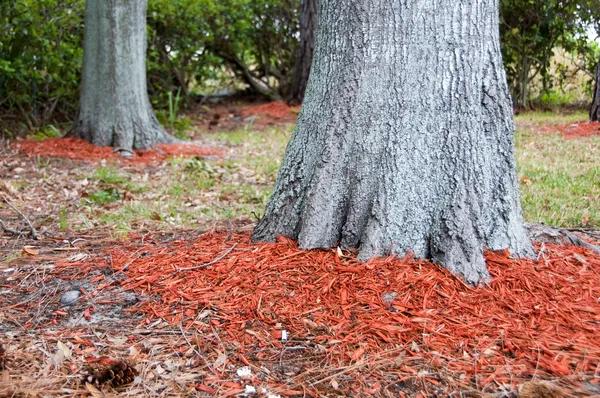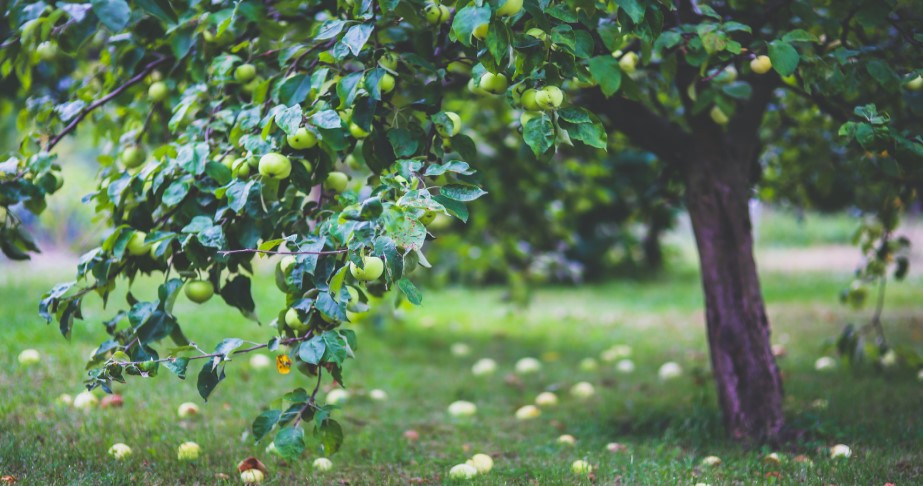Apple trees, with their delightful fruits and graceful branches, add beauty and bounty to any garden or orchard.
They’re deciduous fruit-bearing trees that thrive in well-drained soil with proper moisture retention.
To ensure the optimal growth and health of your apple trees, mulching is a crucial practice that should not be overlooked.
Mulch provides numerous benefits that support the growth and health of apple trees by conserving moisture, regulating soil temperature, suppressing weeds, and enriching the soil.
Whether you’re a seasoned orchardist or an aspiring apple enthusiast, this article will equip you with the knowledge and tools to give your trees the care they deserve.
Best Mulches for Apple Trees
The recommended types of mulches for apple trees can be categorized into organic and inorganic variants.
- Organic Mulch Options
1. Straw or Hay
This acts as a protective barrier, reducing water evaporation and suppressing weed growth.
It also breaks down gradually, enriching the soil with organic matter.
Pros
- It helps to maintain soil moisture
- Suppresses weed growth, minimizing competition for nutrients and water
- Improves soil fertility
Cons
- Can be less aesthetically pleasing compared to other mulch options
- Requires more frequent replenishment as it decomposes relatively quickly
- May attract pests like slugs and rodents if not managed properly
Related: Root Mulch vs. Bark Mulch: Comparison
2. Wood Chips or Bark

They provide excellent moisture retention, weed control, and insulation for apple tree roots.
They gradually decompose, improving soil structure and fertility over time.
Pros
- Excellent moisture retention properties, helping to keep the soil evenly moist around the apple tree roots
- Effective in weed control by suppressing weed growth and preventing weed seeds from germinating
- It improves soil aeration
Cons
- The decomposition process may temporarily deplete soil nitrogen levels if not balanced with nitrogen-rich amendments
- Fresh wood chips can compete with apple tree roots for nitrogen during decomposition
- Thick layers of wood chips can retain too much moisture, leading to root rot if not properly managed
3. Leaves or Compost
Leaves or compost make fantastic mulch options, as they enrich the soil with nutrients, promote microbial activity, and improve moisture retention.
Pros
- Enriches the soil with nutrients as the leaves or compost break down, providing a steady supply of organic matter
- Promotes beneficial microbial activity in the soil, supporting overall soil health
- Improves moisture retention by preventing evaporation from the soil surface
Cons
- Whole leaves can mat together, potentially suffocating the soil and inhibiting water infiltration. Shredding the leaves is recommended to prevent matting
- May require more frequent application or supplementation with additional organic matter to maintain adequate mulch depth
- Can attract pests if not managed properly, particularly if fresh kitchen scraps are included in the compost
Shredded leaves work best to prevent matting and smothering.

Related: Is Cedar Mulch Good for Fruit Trees?
- Inorganic Mulch Options
4. Plastic or Landscape Fabric
This option is durable, offers exceptional weed suppression, and conserves moisture effectively.
It’s ideal for orchard settings where a long-lasting mulch solution is desired.
Pros
- Durable and long-lasting, providing an effective barrier against weeds
- Excellent moisture conservation, reducing water evaporation and maintaining consistent soil moisture levels
- Easy to install and requires minimal maintenance
Cons
- Doesn’t contribute to soil fertility or organic matter content
- Impedes nutrient cycling and microbial activity in the soil
- Inflexible and can inhibit the exchange of gases between the soil and the atmosphere
5. Gravel or Stones
With this, you get excellent drainage, especially for apple trees that are susceptible to root rot.
It helps retain soil moisture and creates a distinctive aesthetic appeal.
Pros
- Provides excellent drainage, preventing excess water accumulation around the apple tree roots
- Helps retain soil moisture by reducing evaporation from the soil surface
- Adds aesthetic appeal to the orchard setting
Cons
- Doesn’t provide any organic matter or nutrients to the soil
- Lack of organic matter may lead to reduced soil fertility over time
- Can heat up quickly under direct sunlight, potentially affecting soil temperature and moisture levels
Related: Best Mulches for Citrus Trees in Pots
Mulching Techniques for Apple Trees

You must follow proper mulching techniques to maximize the benefits of mulching and ensure the health of your apple trees.
Let’s take a look at each technique.
Correct mulch application methods
When applying mulch around apple trees, avoid the common mistake of piling mulch against the trunk, also known as volcano mulching.
This practice creates a mound of mulch that touches the trunk directly, leading to several issues.
Moisture retention occurs when water collects against the trunk, promoting rot and fungal diseases.
Additionally, pests and rodents find a favorable habitat in the moist mulch, potentially causing damage to the tree.
Instead, adopt the mulch donut method.
Start by spreading the mulch in a circular shape around the base of the tree, resembling a donut. Ensure that it doesn’t come into direct contact with the trunk.
Leave a small gap of about 2-3 inches between the mulch and the trunk to allow proper air circulation and prevent moisture accumulation.
Determining the appropriate depth of mulch
Mulch depth is crucial for providing optimal benefits to your apple trees.
Generally, a layer of 2-4 inches of mulch is recommended.
This depth ensures that the root zone of the tree is adequately covered, providing insulation, moisture retention, and weed suppression.
However, be cautious not to suffocate the tree by applying an excessive amount of mulch, as it can restrict the exchange of air and water to the roots.
Measure the depth of the mulch using a ruler or simply estimate the thickness.
Periodically check the depth and adjust it as necessary to maintain the desired thickness.
Keep in mind that organic mulches will gradually decompose over time, so regular replenishment may be required to maintain the proper depth.
Creating a mulch-free zone
While mulch offers numerous benefits, it’s essential to leave a small gap or mulch-free zone around the base of the tree.
This gap should be approximately 2-3 inches wide and extend around the circumference of the trunk.
Creating a mulch-free zone serves multiple purposes.
Firstly, it helps prevent excess moisture retention against the trunk, reducing the risk of rot and disease.
By allowing airflow around the base of the tree, the mulch-free zone helps to keep the trunk dry and healthy.
It also acts as a deterrent to pests and rodents, as they’re less likely to take shelter near the tree when there’s no direct access to the mulch.
When creating the mulch-free zone, ensure that the gap is maintained consistently as you refresh or replenish the mulch.
Regularly inspect the area and adjust the mulch as needed to maintain the appropriate distance from the trunk.
Related
- Best Gravels to Walk on Bare Feet
- 10 Best Mulch for Wet Areas
- Top 7 Disadvantages of Decomposed Granite
- Grass Mulching Pros and Cons
- Gorilla Hair Mulch Pros and Cons
- Best Mulch for Perennials
- Where to Get Wood Chips for Gardens
- Best Mulch for Raised Vegetable Bed Garden
- Top 10 Wholesale Mulch Suppliers
- Top 10 Places Where to Buy Roof Gravel
- Best Cedar Mulch for a Vegetable Garden
- 6 Best Mulches for Peach Trees


